The Internet is rapidly evolving. Every second, we’re getting closer to fully defining Web3 and making it widely accessible to all. But what is Web3? And what makes it different from what we have now? Why are we headed there, and how will it impact the way we currently use the internet? Should you start investing in Web3 Marketing?
A Primer on Web3 Marketing:
What is Web3?
Web3 (also Web 3.0) is the natural evolution of the World Wide Web from Web 1.0 and Web 2.0. The World Wide Web is the system of linked documents that we access via the Internet.
Web 1.0 was characterized by static pages and images. It was a read-only web where consumers cannot edit content. This was the era of personal websites where only a webmaster was capable of changing items on a site. Web 1.0 is often called the Hypertext Web.
In the early 2000s, social media sites started to rise and Web 2.0 was born. Web 2.0 is the read and write web where users can input data that are processed and stored. Instead of a one-directional interaction like Web 1.0, Web 2.0 is bi-directional. Web 2.0 gave birth to content creators since publishing content on the internet became easy and accessible. Web 2.0 is called the Social Web because of the participation and interaction of billions of users to create it.
Web 1.0 lasted from the early 90s to the early 2000s. Web 2.0 lasted from the early 2000s and remains prevalent today. But there’s a new kind of World Wide Web we’re looking at – Web 3.0.
Web 3.0 is called the Semantic Web. It is still largely undefined but users are looking at it as a more decentralized web where users can easily build applications that other users would interact with and use. With Web 2.0, the companies who collect user data own that data. Everything is stored in a centralized server. Web 3.0 aims to break that by letting users own their data and have it stored in various decentralized servers.
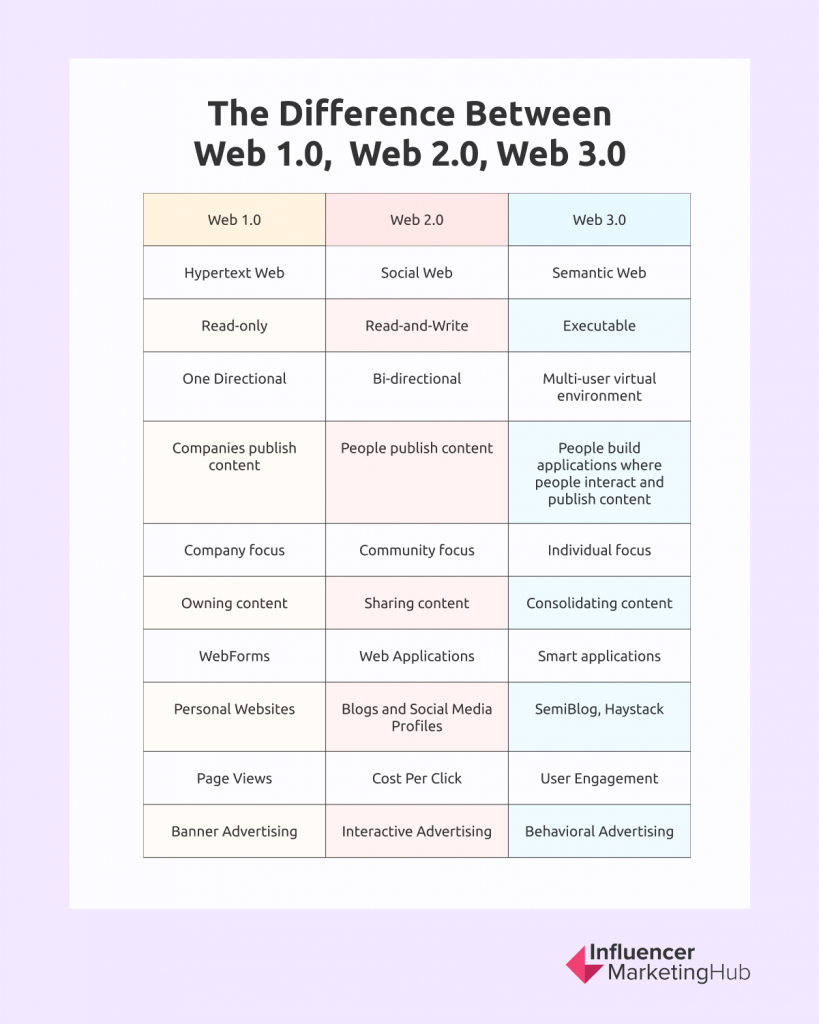
The Characteristics of Web3
To further understand Web3, let’s look at its defining characteristics.
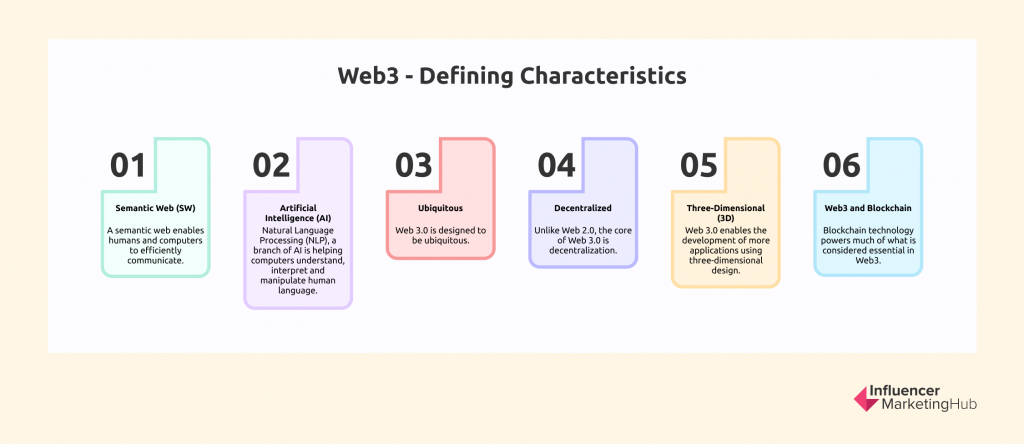
Semantic Web (SW)
A semantic web enables humans and computers to efficiently communicate. Machines will be able to understand and respond to complex human requests. Think of “talking” to a computer the same way you’d talk to a friend. You use natural words and conversations to convey your requests.
We’ve seen this evolution with Google Search. The search engine has already evolved to display search results based on actual user questions instead of awkward keywords. Imagine this happening on a wider scale beyond search engines.
Web 3.0 focuses on how the backend of the internet is structured. By structuring information semantically, these kinds of “natural conversations” with computers will be possible.
Artificial Intelligence (AI)
Humans and computers speak different languages. The backend of the Internet is built using codes that machines understand. Meanwhile, humans have to input data in unnatural ways that will fit what’s already coded. This is changing.
Natural Language Processing (NLP) is helping computers understand, interpret and manipulate human language. NLP is a branch of artificial intelligence (AI) that aims to help computers and humans communicate better.
Today, we can simply say “Alexa, I like this song”, to which our device will respond “Ok, rating saved”, and then save the song for future playback. NLP is highly useful in powering smart devices so we can easily communicate with them as we would with a normal person.
Web 3.0 uses this technology so that computers would better understand a user’s data inputs. In return, they would generate accurate and quick responses.
Ubiquitous
Web 3.0 is designed to be ubiquitous. This means it will be accessible by anyone, on any device, and in any application.
A ubiquitous web is what makes the Internet of Things (IoT) possible. IoT refers to the collection of network-enabled devices that communicate with each other using Internet Protocol (IP). This includes smart appliances, wearable devices, home security systems, and computer peripherals.
Decentralized
The core of Web 3.0 is decentralization. Unlike Web 2.0 where information is stored in a single server at a specific location, information on Web 3.0 will be stored simultaneously in various locations. There is no central data storage.
This provides several benefits such as:
- Reduced risk of server failures
- Reduced risk of data theft
- Increased data ownership
Decentralization will address the pressing issues surrounding data privacy and data security plaguing Web 2.0 today.
Three-Dimensional (3D)
Web 3.0 enables the development of more applications using three-dimensional design. We would see more virtual reality (VR), augmented reality (AR), and 3D product visualizations.
3D helps people understand each other better and we can expect more creators to invest in 3D design as Web 3.0 further develops.
Web3 and Blockchain
Blockchain technology powers much of what is considered essential in Web3. Blockchain is a rapidly developing technology that creates an open ecosystem by getting rid of centralized systems. This paves the way for data security and data decentralization, which are key qualities of Web 3.0.
Blockchain technology creates a transparent web that increases consumer trust. This will lead to better and more efficient Web3 marketing strategies.
What is Web3 Marketing?
As the World Wide Web evolved, marketing trends have always followed. To better understand the opportunities in Web3 Marketing, let’s look at marketing in Web 1.0 and Web 2.0.
Marketing in Web 1.0
During the days of Web 1.0, there were only very few content creators and the majority of Internet users were consumers. Personal pages were common and they consisted of static pages hosted by paid web servers (thru internet service providers) or free web hosting services.
Web advertisements were banned and marketers had to rely on collecting emails for email marketing and simply using online messaging to reinforce traditional ads via TV, radio, and print.
Search Engine Optimization was in its infancy and SEO tactics were crude.
There was potential for digital marketing but it was very rudimentary.
Marketing in Web 2.0
The development of Web 2.0 gave rise to the digital marketing explosion. As the web evolved to be consumer-first, data-driven, and mobile-first, so have the various potentials for digital marketing tactics. The growth of social media platforms like Facebook paved the way for targeted ads.
Digital marketing became performance and analytics-oriented. Platforms collected so much data and made it available to marketers through targeted advertisements. As a result, brands began to understand their audiences more.
Web 2.0 marketing gave rise to:
- Geo-targeted ads
- Direct-To-Consumer (DTC) brands
- Interest-based advertising
- Influencer marketing
- Sophisticated cross-channel customer communications
- Mobile ads
- Improved SEO strategies
The unprecedented influx of data is every marketer’s dream. By collecting as much data from their target audience, marketers can craft better campaigns and offers that will entice and delight their customers.
However, this flood of data that marketers love is exactly what Web 3.0 hopes to address.
Marketing in Web 3.0
Web 2.0 focused on improving the front-end of the internet. Web 3.0 is focusing on improving the back end. In Web 2.0, data was collected and controlled by platforms and companies. Companies like Facebook own our data and decide how to share this data with advertisers. Marketers only need to deal with the platform to access the data and create strategies to acquire, retain, and engage their customers.
With Web 3.0, data will be controlled by private citizens rather than private entities. No single entity or person will own the data in Web 3.0. Rather than storing data in centralized locations (like Facebook, Google, or Amazon), data will be stored in a distributed network that’s owned by no one.
This gives users control of their data. They can decide where and how to share it. Marketers, in turn, have more stakeholders to market to, engage with, and retain. These stakeholders include users, developers, and the communities they engage with.

Source: reforge.com
Web 3.0 will usher in the evolution of community marketing. As the stakeholders expand, marketers have to invest time and resources in learning what customers care about and building strategies around it. Channels used with Web 2.0 like content marketing and SEO will remain but these have to be used alongside Web3 developments like NFTs and tokens.
The Impact of Web3 on Marketers
Web 3 will challenge marketers but it will also provide new opportunities for acquiring and retaining customers.
- Limited access to user data
Web 3.0 will usher in greater data privacy. Consumers would be able to control their data and how it’s used by companies. This will force marketers to be more transparent and creative in their data acquisition methods.
- Community-focused approach
The rapid development of Web 3.0 is due in part to a growing distrust of how brands and companies use consumer data. With Web 3.0, marketers have to focus on building loyal and engaged communities who will willingly part with their data and even become brand advocates.
- Increased role of content creators
Today, content creators are at the mercy of the platforms they choose to publish in. They have to abide by strict guidelines and contend with limited earning potential. Creators also get only a fraction of what platforms make from the content they produce. Web 3.0 will grant full autonomy to creators in deciding their content and getting paid for it. Web 3.0 will usher in a new revenue model where creators will be in control.
Preparing Your Brand for Web 3.0 Marketing
A marketing revolution is about to happen. Indeed, Web 3.0 is still under development but it may arrive sooner than we realize. Parts of it are already here, and we must be ready to ride the wave when it fully arrives.
Here are ways you can prepare your brand to adapt Web3 marketing strategies.
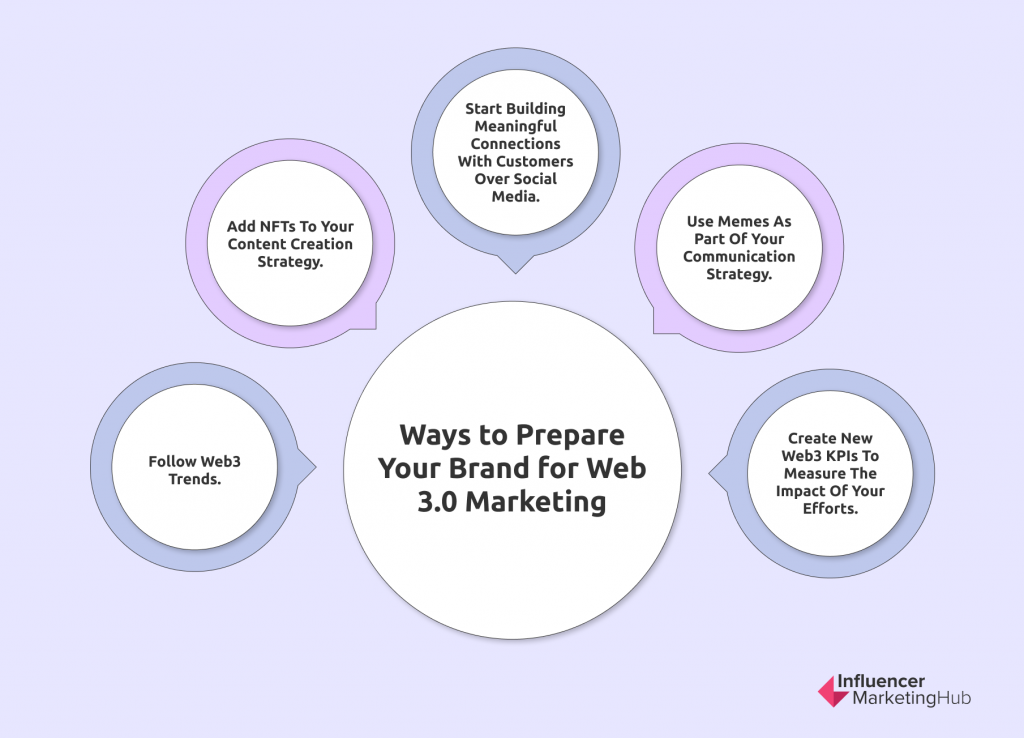
- Follow Web3 trends.
Being outdated can be costly. There are a lot of uncertainties but there are also a lot of developments. When making business decisions, remember that the future is here and it’s rapidly changing. Depending on your brand, try to acquire 3D assets like 3D models or virtual reality stores. The more you know about the latest Web 3.0 trends, the more you’ll discover ways to integrate them into your current strategies.
- Add NFTs to your content creation strategy.
There are no guidebooks or rulebooks regarding content creation for Web 3.0 but everyone agrees it will involve NFTs. NFTs (non-fungible tokens) are pieces of IP that live on the blockchain and drive digital scarcity. For brands that have started creating them, it has served several purposes such as:
- Increased brand awareness and reach
- Novel experiences and exclusive access
- Increased brand loyalty
- Start building meaningful connections with customers over social media.
Social media will continue to be a big part of Web 3.0 although with some major changes. Users would be in control of their data due to decentralization. Building meaningful connections with customers this early will cement their relationship with your brands and make them willing to trust you with their data.
Marketers should reframe how they look at their customers. Instead of merely seeing them as numbers or data points, they must be invested in building lasting relationships that transcend beyond data. Community building is, as previously stated, the core of Web 3 marketing. Even before products could be launched, having a strong community is imperative. Some products may even come from the community.
- Use memes as part of your communication strategy.
Memes are considered a universal language on the internet and the Web 3 community are big fans of it. Memes are approachable, elicit emotions, and have a human feel. They are keys to making projects relatable.
- Create new Web3 KPIs to measure the impact of your efforts.
Web 3 will have marketers rethink how to measure growth performance. The key performance indicators (KPIs) applicable to Web 2 may not necessarily apply to Web3. Some of the metrics you can use for Web3 include:
- Size of community across channels
- Activity and engagement
- NFT sell-out time or “floor price”. A steady or consistent increase in NFT price indicates that your customers believe in the NFT project.
Most of these metrics are still in their infancy as much of Web 3 remains to be developed and uncovered. For now, marketers can focus on metrics that gauge product and community engagement. As Web3 matures, other metrics would likely surface.
Existing Challenges with Web 3.0
Before you get too excited and launch Web3 marketing campaigns, it’s also important to understand the current challenges surrounding it. This will help you further assess how soon the technology will arrive and impact your business.
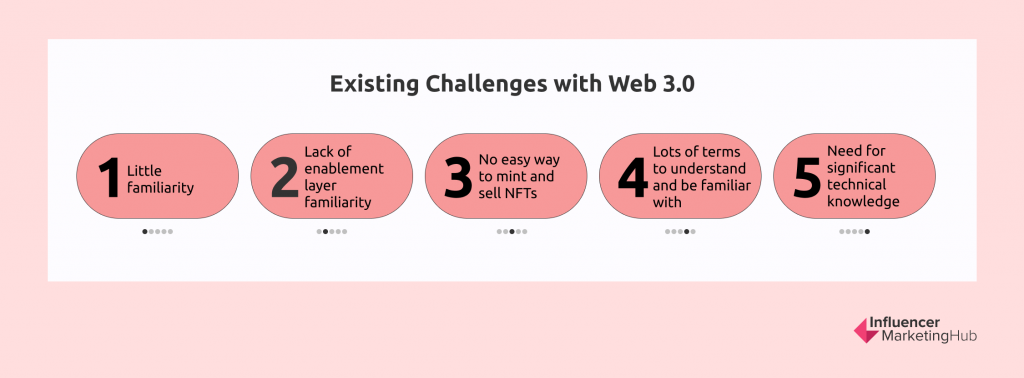
- Little familiarity
Only 25% of US adults are familiar with NFTs and only 7% are actively using them despite their novelty. This indicates that mass adoption is a long way off and it will take further development and awareness for the technology to catch on.
- Lack of enablement layer
Buying and selling NFTs requires cryptocurrency which requires crypto wallets. There are no mainstream platforms that cater to non-crypto users interested in NFTs. This provides further barriers, especially for people who are not familiar with the crypto world.
- No easy way to mint and sell NFTs
Creators interested in making and selling NFTs have a hard time finding a platform to easily and quickly achieve their goals. DTC boomed when Shopify built a platform where users can create their own branded online store and sell their products without writing a single line of code. Some platforms have attempted to create an NFT buy-and-sell experience that resembles online shopping but they are still in their infancy.
- Lots of terms to understand and be familiar with
For the average buyer or creator to get into the NFT space, they need to be familiar with the language. Terms like DAOs, NFTs, decentralized, etc. can get confusing pretty fast and users spend weeks and months researching these topics.
- Need for significant technical knowledge
Creating NFTs and DAOs (decentralized autonomous organizations) requires significant technical knowledge. Users must understand how to deploy smart contracts. This can be very technical for a majority of users and presents a barrier to truly immersing in the experience.
Despite these challenges, the development of Web 3.0 is in full swing as developers race to create platforms to make it more accessible to average users. Novel and Dime are emerging platforms that offer no-code creation, minting, and selling of NFTs.

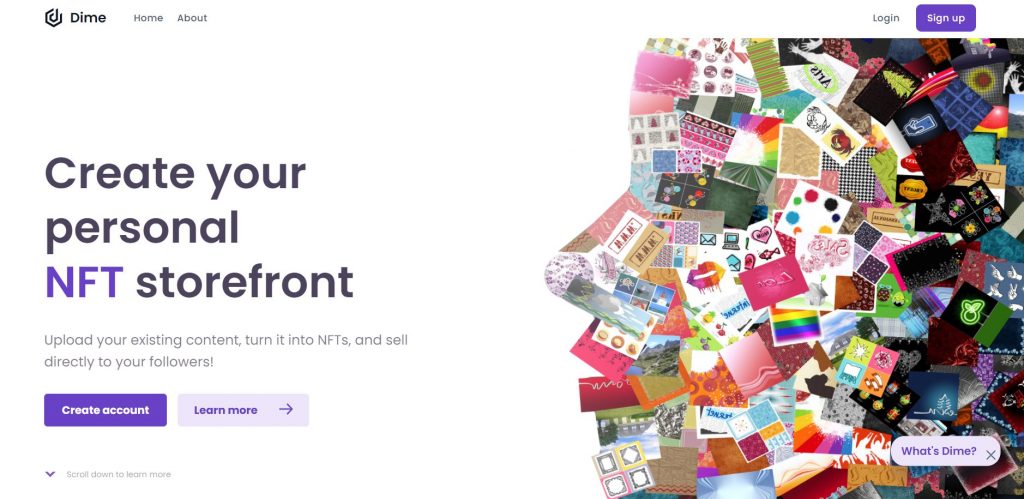
Source: dime.io
Final Thoughts
Web 3.0 is still in its infant stages even as it rapidly develops. No one knows for sure what Web 3.0 marketing would look like although there is a huge spotlight on community marketing. The marketing strategies and roles that will be in demand as Web 3.0 mature remain to be seen.
Regardless, marketers should be savvy enough to adapt to changing trends and seize emerging opportunities.
Frequently Asked Questions
What does Web 3.0 mean for marketing?
Web 3.0 is built around data privacy for users. Currently, users give up precious data to platforms that control how these data are used. Companies profit from sharing these data with third-party advertisers who maximize the information to their benefit.
While a lot remains to be seen as Web 3.0 matures, it’s certain that users will have more control over their data and who they share it with. This could pose a challenge for marketers who are used to securing data from existing platforms and using it to acquire, engage and retain customers.
Marketers should start focusing on building relevant and strong communities that users would trust enough to share personal data as well as recommend others. Community marketing is seen as the primary marketing strategy for Web 3.0.
What does Web 3.0 mean for brands?
Web 3.0 is mostly viewed as an upgraded Web 2.0 characterized by the presence of virtual reality and augmented reality. With Web 3.0, brands can create virtual experiences like virtual stores where users can interact with each other and purchase products.
Web 3.0 opens the possibility for more immersive and interactive spaces for brands to showcase their personality to users. Brands can also create new kinds of collectible items such as NFTs (non-fungible tokens) that further drive their value and relevance to their consumers.
How will Web 3.0 affect search marketing?
Web 3.0 aims to make humans and computers communicate seamlessly and efficiently through the use of the semantic web. This means that natural search queries will be understood accurately and instantaneously by search engines. This translates to a more personalized browsing experience for the user.
For brands, this presents opportunities to create rich and interactive ads that continue to feel natural and non-invasive to users.
What are examples of Web 3.0?
Web 3.0 already exists, although it is still widely underdeveloped. It may take several years for it to fully mature. However, here are several examples of websites and applications running on Web 3.0.
- Bitcoin – the original cryptocurrency
- OpenSea – NFT marketplace
- Steemit – blogging platform that uses blockchain
- Diaspora – decentralized social network
- Apple’s Siri – voice recognition software
s


